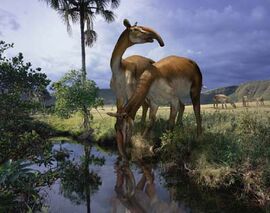South America had been cut off from the rest of the world for 30 [[|{{{1}}}]]
| Pliocene | |||
|---|---|---|---|

| |||
| Previous period Miocene |
Following period Pleistocene | ||
million years. In this time, all sorts of huge, outlandish creatures have been able to evolve. Animals not found anywhere else on the planet. For 40 million years, the plains of South America have been ruled by an awesome group of predators…the aptly named Terror Birds. Since splitting from Antarctica 30 MYA, South America has been isolated from the world and as a result, its animals are unique.
The Pliocene or the Pliocene epoch is the second epoch of the Neogene, located between Miocene and Pleistocene. It began about 9.3 million years ago and ended 2 million years ago, lasting for about 7 million years.
During the Pliocene the northern hemisphere experienced a gradual change of the climate that became increasingly dry and cool. In the southern hemisphere, Antarctic ice continued to grow.
The Pliocene plants became more cold tolerant, open spaces increased (Next of Kin).

Pliocene animals (also see below) includes the direct ancestors of modern horses, elephants, rhinoceroses, hoofed animals (Blood Brothers), etc. As shown by both Walking with Beasts and Walking with Cavemen, this was the time when the more advances species of Australopithecus began to evolve into human ancestors in Africa. Other animals living in Africa alongside Australopithecus include the highly aggressive elephant-like Deinotherium, the early sabre-tooth cat Dinofelis and the gentle herbivores like Ancylotherium.
About 2.5 million years ago, the continent of South America collided with North America, causing the Great Faunal Interchange. Placental mammals like Smilodon moved to the south, while the South American endemics, like Doedicurus and the terror birds moved to the north.
